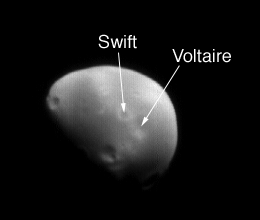Deimos (moon)
Deimos is one of the two moons of Mars, the other being Phobos. Unlike its larger sibling, Deimos is smaller and further away from Mars, exhibiting a more circular orbit. This article focuses on the characteristics, exploration, and significance of Deimos in the context of solar system studies and space exploration.
Characteristics[edit | edit source]
Deimos has a mean radius of approximately 6.2 kilometers, making it significantly smaller than Phobos. Its composition is thought to be similar to Type I carbonaceous chondrite meteorites, suggesting a possibly different origin from Mars itself. Deimos's surface is smoother than that of Phobos, with fewer large craters and a generally more uniform appearance. This is partly due to the moon's weaker gravity, which fails to retain any ejected material from impacts.
The moon's orbit is almost circular, with an average distance of about 23,460 kilometers from Mars, and it completes an orbit around the planet in approximately 30.3 hours. This orbital period is significantly longer than the Martian day (or sol), making Deimos the only natural satellite in the Solar System that appears to move westward across the sky from the perspective of an observer on the surface of its planet.
Exploration[edit | edit source]
Deimos has been observed by several spacecraft that have visited Mars. The first close-up images were taken by the Viking 1 orbiter in 1977, revealing a smooth, heavily cratered surface. Subsequent missions, including Mars Global Surveyor and Mars Reconnaissance Orbiter, have provided more detailed images and data, contributing to our understanding of its composition and orbit.
Despite its proximity to Mars, there have been no dedicated missions to Deimos. However, the moon's low gravity and stable orbit make it an attractive target for future exploration missions, potentially serving as a base for the exploration of Mars or as a source of materials.
Significance[edit | edit source]
The study of Deimos, alongside Phobos, offers valuable insights into the early solar system. Understanding the moons' origins—whether they are captured asteroids or formed from debris around Mars—can provide clues about the processes that shaped the inner solar system. Additionally, Deimos's stable orbit and low gravity may make it an ideal location for a future space station, from which missions to Mars and beyond could be launched more efficiently than from Earth.
Future Missions[edit | edit source]
Several space agencies have proposed missions to explore Deimos and Phobos in more detail. These missions aim to study the moons' surface composition, internal structure, and potential for supporting human missions to Mars. By establishing the feasibility of using Deimos as a staging area, these missions could play a crucial role in the future of human space exploration.
Search WikiMD
Ad.Tired of being Overweight? Try W8MD's physician weight loss program.
Semaglutide (Ozempic / Wegovy and Tirzepatide (Mounjaro / Zepbound) available.
Advertise on WikiMD
|
WikiMD's Wellness Encyclopedia |
| Let Food Be Thy Medicine Medicine Thy Food - Hippocrates |
Translate this page: - East Asian
中文,
日本,
한국어,
South Asian
हिन्दी,
தமிழ்,
తెలుగు,
Urdu,
ಕನ್ನಡ,
Southeast Asian
Indonesian,
Vietnamese,
Thai,
မြန်မာဘာသာ,
বাংলা
European
español,
Deutsch,
français,
Greek,
português do Brasil,
polski,
română,
русский,
Nederlands,
norsk,
svenska,
suomi,
Italian
Middle Eastern & African
عربى,
Turkish,
Persian,
Hebrew,
Afrikaans,
isiZulu,
Kiswahili,
Other
Bulgarian,
Hungarian,
Czech,
Swedish,
മലയാളം,
मराठी,
ਪੰਜਾਬੀ,
ગુજરાતી,
Portuguese,
Ukrainian
Medical Disclaimer: WikiMD is not a substitute for professional medical advice. The information on WikiMD is provided as an information resource only, may be incorrect, outdated or misleading, and is not to be used or relied on for any diagnostic or treatment purposes. Please consult your health care provider before making any healthcare decisions or for guidance about a specific medical condition. WikiMD expressly disclaims responsibility, and shall have no liability, for any damages, loss, injury, or liability whatsoever suffered as a result of your reliance on the information contained in this site. By visiting this site you agree to the foregoing terms and conditions, which may from time to time be changed or supplemented by WikiMD. If you do not agree to the foregoing terms and conditions, you should not enter or use this site. See full disclaimer.
Credits:Most images are courtesy of Wikimedia commons, and templates, categories Wikipedia, licensed under CC BY SA or similar.
Contributors: Prab R. Tumpati, MD




